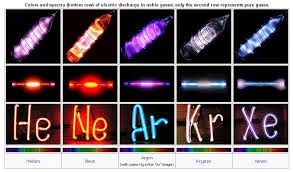
The noble gases are a group of elements in the periodic table. They are located to the far right of the periodic table and make up the eighteenth column. Elements in the noble gas family have atoms with a full outer shell of electrons. They are also called the inert gases. The elements that make up the family of noble gases include helium, neon, argon, krypton, xenon, and radon.
Read Also: John Dalton
What are the similar properties of noble gases?
Noble gases share many similar properties including:
- A full outer shell of electrons. Helium has two electrons in its outer shell and the rest have eight electrons.
- Because of their full outer shells, they are very inert and stable. This means they don’t tend to react with other elements to form compounds.
- They are gases under standard conditions.
- They are colourless and odourless.
- Their melting and boiling points are close together giving them a very narrow liquid range.
Abundance
Helium is the second most abundant element in the universe after hydrogen. Helium makes up about 24% of the mass of the elements in the universe. Neon is the fifth most abundant and argon is the eleventh.On Earth, the noble gases are fairly rare with the exception of argon. Argon makes up just under 1% of the Earth’s atmosphere, making it the third most abundant gas in the atmosphere after nitrogen and oxygen.
Also Read: Halogens
Radon
such as basements. Due to its colourless property, it can’t be detected easily. Radon accumulating indoors is a serious health hazard. This is because when radon breaks down, it produces charged particles that become a part of the
dust, and are dangerous when inhaled. This hazard is also posed in structures constructed from certain granites. Radon does have its uses too. Radon-222, the most common isotope, is used in the treatment of malignant tumours.
Interesting Facts about Noble Gases
- Because helium is non-flammable it is much safer to use in balloons than hydrogen.
- Krypton gets its name from the Greek word “kryptos” meaning “the hidden one.”
- Many of the noble gases were either discovered or isolated by Scottish chemist Sir William Ramsay.
- Helium has the lowest melting and boiling points of any substance.
- All of the noble gases except for radon have stable isotopes.
- Neon signs do not use just neon gas, but a mixture of different noble gases and other elements to create bright lights of different colours.
- Noble gases are often used to create a safe or inert atmosphere due to their stable nature.
- Xenon gets its name from the Greek word “xenos” which means “stranger or foreigner.”
- Sir William Ramsay (1852-1916) was a British chemist, and was the first to successfully isolate all of the noble gases, except radon. He also discovered 4 of them, namely neon, argon, krypton, and xenon.
- Pierre Janssen discovered helium in 1868 during a solar eclipse in the spectrum of the corona of the sun. However, Ramsay was the first to isolate it.
- Ramsay and the British physicist Lord Raleigh found that nitrogen removed from the atmosphere was denser than nitrogen formed by the decomposition of ammonium nitrate. This led to the discovery of argon in 1894.
- Helium was discovered by Janssen in 1895. Through the attempts of Ramsay and his assistant Morris Travers, krypton, neon and xenon were found from the atmosphere by fractional distillation.
- Radon was discovered by a German chemist, Friedrich Ernst Dorn in 1900.

